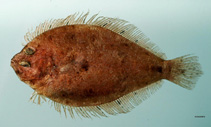| Family: |
Cyclopsettidae (Sand whiffs) |
| Max. size: |
20 cm TL (male/unsexed) |
| Environment: |
reef-associated; brackish; marine; depth range 27 - 95 m |
| Distribution: |
Western Atlantic: northeastern Florida (USA), Gulf of Mexico, and the Antilles to Guyana. |
| Diagnosis: |
|
| Biology: |
Found between the shore and 100 m depth, on sand or mud bottoms rich in organic matter. Feed mainly on shrimps (Penaeidae), amphipods, crustacean larvae and annelids. The whole life cycle develops on the continental shelf. During reproduction in May and September, adults gather in shallow waters of the estuaries and along the coast. Sexual activity takes place during the rainy season which corresponds to quite a large influx of organic matter, thereby ensuring food for the breeding fish. Sexual dimorphism affects the interorbital width and pectoral fin length of the hidden side. Juveniles remain planktonic for a long time with a high growth rate of >5% per day (Ref. 35237). |
| IUCN Red List Status: |
Least Concern (LC); Date assessed: 29 January 2013 Ref. (130435)
|
| Threat to humans: |
harmless |
Source and more info: www.fishbase.org. For personal, classroom, and other internal use only. Not for publication.

